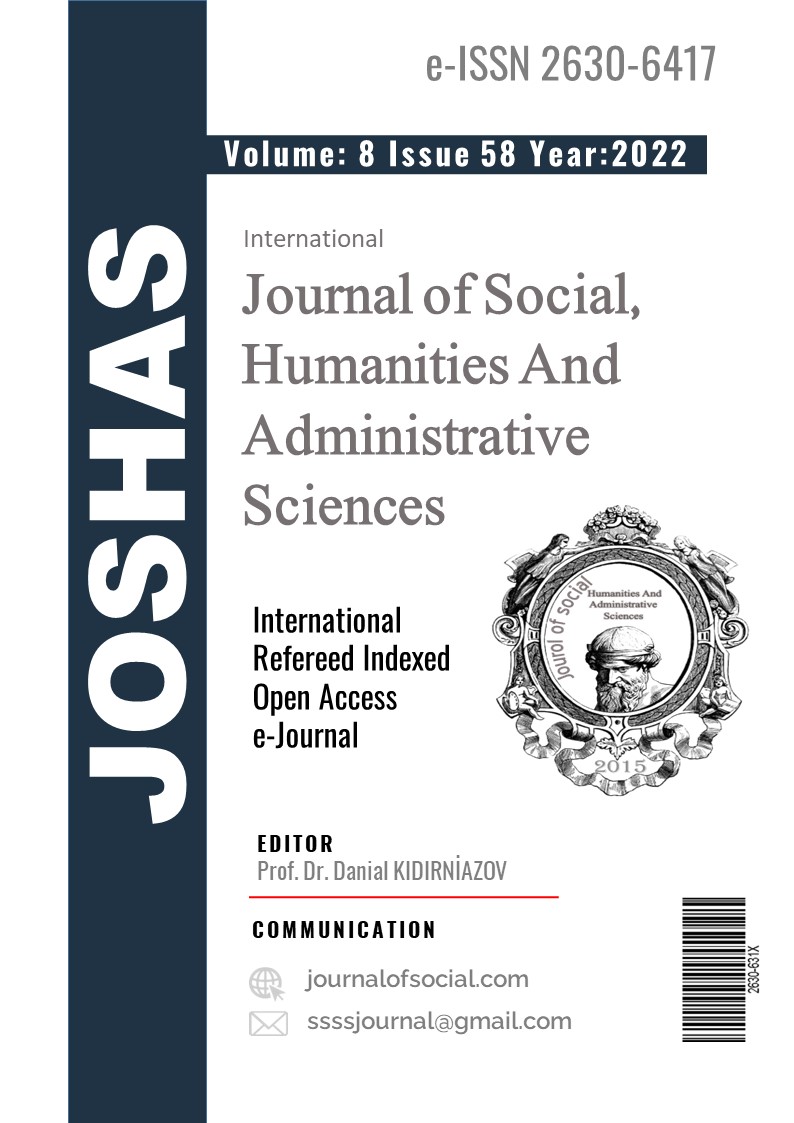Author :
Abstract
Duygular, öteden beri sanatçıların kendilerini ifade etmede önemli bir unsur oluşturmaktadır. Duyguların aktarımında sanatçının önceliği kendi benliği ve öznel yapısı olduğunda, ekspresyonist resimden söz etmek mümkündür. Ekspresyonist resim; içsel durumun dışsal imgelerle alışılagelmiş normlardan uzak bir çeşit aktarımıdır. Yaşanılan hayatın kişide oluşturduğu psikolojik sorunlar ya da toplumsal sorunların kişiyi derinden etkilemesi gibi durumlar, duygusal reaksiyonlara yol açmakta ve bu durum sanatçının resminde ifade aracı olarak öne çıkmaktadır. Rengin ve biçimin aktarımı duygularla bütünleşmiş olduğundan bu durum bazen hüzünlü, bazen öfkeli bazen de isyankâr olabilmektedir. Dolayısıyla renk ve biçimin, anlatılmak istenene hizmet ettiği söylenebilir. Ekspresyonist sanatçılar, duygularını dile getirirken çeşitli ifade yollarına gitmiştir. Ekspresif figüratif resim bunlardan biridir. Sanatçılar, duygularını figürlere yüklediği ifadelerle öne çıkarmaktadırlar. Özellikle canlı figürler, duyguların aktarımında daha etkili olabilmektedirler. Yüz ve bedensel ifade bu etkiyi güçlendiren başlıca unsurlardandır. Ekspresif resimde figüratif anlayışla çalışan önemli sanatçılardan biri de Edvard Munch’ tır. Onun resimlerinde birçok duygusal yansıma görmek mümkündür. Yaşadığı hayatın onda bıraktığı inişli çıkışlı durumlar, onu derinden etkilemiş bu durumda onun resimlerine çeşitli duygusal tepkilerle yansımıştır. Bu duygusal yansımaları saptamak amacıyla Edvard Munch’ın figüratif resimlerindeki duygu çeşitlilikleri, eser analizi metodu ile incelenmiş, araştırma literatür taramasıyla da desteklenmiştir. Sonuçta Munch’ın resimlerinde acı, üzüntü, keder, şaşkınlık, pişmanlık, utanç, endişe, korku, çaresizlik gibi negatif duygu çeşitlilikleri tespit edilmiştir.
Keywords
Abstract
Emotions have always been an important element for artists to express themselves. It is possible to talk about expressionist painting when the artist's priority in the transfer of emotions is his own self and subjective structure. Expressionist painting; It is a kind of transference of the internal state away from the usual norms with external images. Situations such as the psychological problems caused by the life lived in the person or the social problems affecting the person deeply cause emotional reactions and this situation stands out as a means of expression in the artist's painting. Since the transfer of color and form is integrated with emotions, this situation can sometimes be sad, sometimes angry and sometimes rebellious. Therefore, it can be said that color and form serve what is meant. Expressionist artists used various means of expression while expressing their feelings. Expressive figurative painting is one of them. Artists highlight their emotions with the expressions they attribute to the figures. Especially lively figures can be more effective in conveying emotions. Facial and bodily expression are the main elements that strengthen this effect. One of the important artists working with a figurative approach in expressive painting is Edvard Munch. It is possible to see many emotional reflections in his paintings. The ups and downs of the life he lived in affected him deeply, and in this case, he reflected on his paintings with various emotional reactions. In order to determine these emotional reflections, the variety of emotions in Edvard Munch's figurative paintings were examined by the artwork analysis method, and the research was supported by a literature review. As a result, negative emotion variations such as pain, sadness, grief, surprise, regret, shame, anxiety, fear and helplessness were identified in Munch's paintings.
Keywords
- 1. Erden, E. O. (2016). “Modern Sanatın Kısa Tarihi”. İstanbul: Hayalperest.
- 1. Erden, E. O. (2016). “Modern Sanatın Kısa Tarihi”. İstanbul: Hayalperest. 2. Eroğlu, Ö. (2015). “Modern Sanat”. İstanbul: Tekhne.
- 3. Gombrich, E. H. (2015). “Sanatın Öyküsü” (Çev. E. Erduran ve Ö. Erduran ). İstanbul: Remzi. 4. Güvemli, Z. (2009). “Sanat Tarihi”. İstanbul: Varlık.
- 5. Hodge, S. (2018). “Sanat” (Çev. M. Üstünipek). İstanbul: İnkılâp.
- 6. Read, H. (2020). “Modern Sanatın Felsefesi”. (Çev. E. Kök ve H. Orgun). İstanbul: Hayalperest.
- 7. Wolf, N. (2005). “Dışavurumculuk (Ekspresyonizm)”. U. Grosenick (Ed.), Metafizik Alman Köftesi İçinde (s. 6- 25). İstanbul: Remzi.
- 8. Yüzgüller, S. (Ed.). (2021). “Sanatın Büyük Ustaları 17, Van Edvard Munch”. İstanbul: Hayalperest.İNTERNET KAYNAKÇASI
- Görsel 1. https://en.artsdot.com/@@/8LT3BM-Otto-Dix-Prager-Stra%C3%9Fe-(Prague-Street) Erişim Tarihi: 02.09.2022
- Görsel 2. https://www.wikiart.org/en/max-beckmann/night-1918 Erişim Tarihi: 02.09.2022
- Görsel3. https://en.wikipedia.org/wiki/The_Funeral_(Grosz)#/media/File:Grosz_Widmung_an_Oskar_Panizza.jpg Erişim Tarihi: 02.09.2022
- Görsel 4. https://www.edvardmunch.org/evening-on-karl-johan-street.jsp Erişim Tarihi: 04.09.2022 Görsel 5. https://www.edvardmunch.org/death-in-the-sickroom.jsp Erişim Tarihi: 04.09.2022
- https://tr.wikipedia.org/wiki/%C3%87%C4%B1%C4%9Fl%C4%B1k_(tablo)#/media/Dosya:The_Scream.jpg Erişim Tarihi: 04.09.2022
- Görsel 7. https://commons.wikimedia.org/wiki/File:Edvard_Munch_-_Eye_in_Eye.jpg Erişim Tarihi: 07.09.2022 Görsel 8. https://www.edvardmunch.org/ashes.jsp Erişim Tarihi: 01.09.2022
- https://wikioo.org/tr/paintings.php?refarticle=8XXU3N&titlepainting=Melancholy&artistname=Edvard%20Munch Görsel 10. https://www.edvardmunch.org/by-the-death-bed.jsp Erişim Tarihi: 01.09.2022
- Görsel12. https://commons.wikimedia.org/wiki/File:Edvard_Munch_-_Jealousy_-_Google_Art_Project.jpg Erişim Tarihi: 04.09.2022
- Görsel13. https://www.pivada.com/en/edvard-munch-self-portrait-between-the-clock-and-the-bed-1940-1943 URL 1. https://www.loveinartsz.com/karl-johan-da-aksam-edward-munch-1892/ Erişim Tarihi: 07.09.2022
- URL 2. https://endemika.online/2020/03/30/edvard-munch-eye-in-eye/ Erişim Tarihi: 01.09.2022
- URL 3. https://www.edvardmunch.org/by-the-death-bed.jsp Erişim Tarihi: 01.09.2022
- URL 4. https://www.mukavemet.org/bulasici-cocuk-hastaliklarinin-ve-asinin-tuvallerdeki-temsili/ Erişim Tarihi: 01.09.2022
- URL 5. https://en.wikipedia.org/wiki/Self-Portrait._Between_the_Clock_and_the_Bed Erişim Tarihi: 04.09.2022





